
Blog
Hurricane Roof Damage: What to Look For and Next Steps
Last year, Florida had its share of hurricane roof damage. The destruction of Ian and Nicole illustrated how widespread hurricane damage is when there are catastrophic winds.
Heavy winds and rain have caused an exponential increase in the amount of storm damage to homes and businesses. These winds are strong enough to cause significant roof damage, often in subtle ways that are hard to spot.
High wind speeds are more likely to affect shingles. To reduce roof damage, asphalt-covered shingles are nailed down. However, if the wind is strong enough, it can tear through the nails that hold them in place.
It’s vital to assess hurricane roof damage as soon as it’s safe to venture outside. Once you suspect your roof has sustained damage, call a roofing company.
As the new hurricane season approaches, here is a list of things to look for after a storm.
Assessing Hurricane Roof Damage

Although roofs are built to withstand the elements, your home may suffer damage from wind, hail, or debris during a severe storm. However, it’s not always easy to spot roof damage.
To quickly restore your home’s privacy, safety, and comfort, homeowners must be able to identify roof damage. Your house may suffer structural damage if nothing is done.
Ensure the storm has passed and it is safe to be outside by staying tuned in to weather reports. Stay away from the area and immediately dial 911 if you observe flooding, electrical hazards, or downed power lines. Once it’s okay to go outside, check the exterior of your home for damage.
If you believe the roof has sustained damage, look for these common signs.
Wind Damage
The main source of hurricane damage is due to high winds. Roofs can be damaged, windows broken, and trees knocked over by high winds. In cases where the shingles are blown away, the roofing underlayment will be exposed to the elements.
Some roof damage is specific to the type of roof. For example, a wood roof may begin to rot, whereas a flat roof might have cracks or surface bubbles. Homeowners should look for cracked, missing, or curled shingles, regardless of the type of roof.
Not only should you check your roof after severe weather, but you’ll also want to examine other components. You’ll also want to inspect your chimney and roofing cement if used in the installation.
Hail Damage
Hail is precipitation that freezes and rains down in the form of solid ice. It isn’t a particular characteristic of a hurricane, but it can form during a storm.
Damage from hail is easy to find. You can hear hail hitting your windows and roof if it’s hailing. You’ll also be able to see ice pellets gathering on the ground.
Hail damage can dent your siding or even shatter your windows. Hail damage to your home’s roof can is easily detectable.
Look for pieces of the roof that are exposed or have gaps in the pattern. Also, look for bent, cracked, dented, or curled shingles. Shingles may also be on the ground near your house.
Check for asphalt granules that may have fallen into the gutters and downspouts. Your gutter’s downspouts and roof flashing may be dented, detached, or missing.
Water Damage
While most hurricane damage is easy to spot, the effects of water damage can take longer to identify. Leaks and water damage that isn’t fixed can grow mold, damaging your home’s foundation and structure.
Signs of water damage can be found in the following places:
- Attic
- Basement
- Ceiling
- Crawl spaces
- Flooring
- Walls
- Windows
Pooled water, in locations it shouldn’t be, is a sign of water intrusion. If left undetected, mold can form. In worst-case scenarios, wood and building materials begin to rot.
Aside from flooding, water intrusion during a hurricane starts with a damaged roof. Without roof repair or replacement, the damage will grow and lead to other issues.
Damaged Shingles

You wouldn’t know the shingle had torn through the nails or black-top just by looking. The only way to know is to go up on the rooftop and lift the lip of the shingle.
Some homes have multiple gables that create valleys in tight areas. Damage isn’t always easy to see from the ground, so a physical inspection is needed.
Visual signs of loose shingles include creases. Unfortunately, creases are difficult to see from the ground because you must be close to recognize the damage.
Even though the shingle is technically still in place, it has been compromised. The damage can make leaks inevitable. A professional roof assessment will determine if the roof can be repaired or needs a full replacement.
Report Damage to the Insurance Company
If you detect hurricane roof damage, you should contact your homeowner’s insurance provider. Report the damage and begin the claim process.
Take pictures and video of the damage before securing your home. Do not discard any materials.
Some insurance providers offer water removal services. Before hiring someone to remove water due to hurricane damage, ensure the insurance provider doesn’t have water mitigation policies.
Call Roofing Contractor
Before hurricane season, it’s a good idea to have a roofing company come out and inspect your roof. Ask them about their response process following a natural disaster.
If you need a roof repair following a severe storm, you should already have a roofing company in mind.
Once you’ve filed a claim for your roof repair, you’ll need to call the roofing contractor. Your insurance company may have requirements you must follow.
Remember, during a hurricane, many homeowners will have roof damage. It’s best to get the ball rolling as soon as possible.
Have the Roof Repaired
Hurricane roof damage is not something you want to put off for too long. As Floridians experienced in 2022, storms can arrive and move quickly. Storms can also form back-to-back, leaving little recovery time.
Begin your preparations early this year. Call (904) 712-3494 and have Avenue Roofing come out to check your roof. You can also click here to schedule a free roof inspection.




